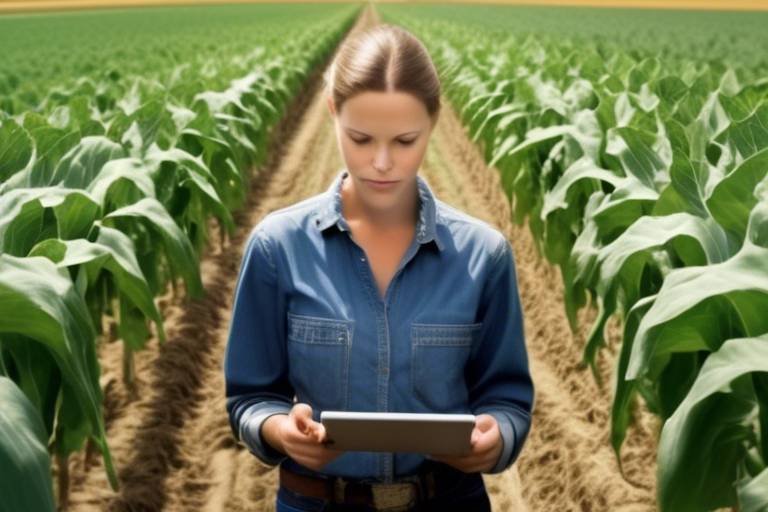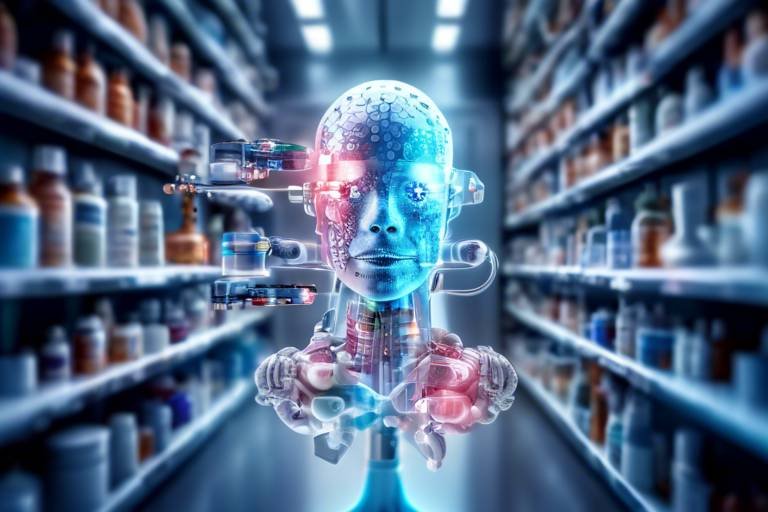The Role of AI in Enhancing Environmental Sustainability
In today's rapidly changing world, the importance of environmental sustainability cannot be overstated. As we face challenges like climate change, resource depletion, and biodiversity loss, innovative solutions are essential to pave the way for a greener future. This is where artificial intelligence (AI) steps in as a game-changer. By harnessing the power of AI, we can optimize processes, analyze data, and implement smart strategies that contribute significantly to sustainability efforts.
Imagine a world where energy is generated and consumed more efficiently, where farmers can grow food with minimal environmental impact, and where waste is managed in a way that promotes recycling and reduces landfill use. AI is making this vision a reality. Through advanced algorithms and machine learning, AI technologies are revolutionizing how we approach environmental challenges. They are not just tools; they are partners in our quest for sustainability.
AI's capabilities extend across various sectors, each playing a vital role in enhancing sustainability. For example, in the renewable energy sector, AI optimizes the generation and distribution of energy, ensuring that we make the most of our renewable resources. In agriculture, AI facilitates precision farming, allowing farmers to use resources more efficiently while boosting crop yields. Furthermore, AI enhances waste management practices, leading to a more circular economy. Each of these applications illustrates how AI can help us reduce our carbon footprint and protect our planet.
As we delve deeper into the specific applications of AI in environmental sustainability, it becomes clear that the future holds immense potential. From smart agriculture practices to innovations in waste management and biodiversity conservation, AI is at the forefront of creating a sustainable world. Let's explore these exciting developments and understand how AI is shaping a greener future for all.

AI in Renewable Energy
Artificial Intelligence (AI) is revolutionizing the way we harness and utilize renewable energy, making it more efficient and sustainable than ever before. Imagine a world where the sun shines brighter, the wind blows stronger, and energy flows seamlessly from renewable sources to our homes and businesses. That’s the power of AI in renewable energy! By leveraging advanced algorithms and data analytics, AI optimizes the generation and distribution of energy, ensuring that we make the most of our natural resources.
One of the most exciting applications of AI in this field is in the management of renewable energy sources like solar and wind power. Traditional energy systems often struggle with unpredictability—solar energy generation fluctuates with cloud cover, and wind energy is dependent on wind speed. However, AI can analyze weather patterns, historical data, and real-time inputs to predict energy generation more accurately. This predictive capability allows energy providers to adjust their operations dynamically, reducing waste and ensuring that energy supply meets demand.
For instance, AI algorithms can forecast the energy output from solar panels based on weather predictions. By integrating this data, energy companies can optimize their grid management, ensuring that energy flows where it is needed most. This not only enhances efficiency but also significantly reduces the reliance on fossil fuels during peak demand times. In fact, studies have shown that AI can increase the efficiency of solar energy systems by up to 20%.
Moreover, AI plays a critical role in the development of smart grids. These advanced electrical grids utilize AI to monitor and manage energy distribution in real-time. They can automatically reroute energy from areas of surplus to areas of need, minimizing waste and improving overall grid reliability. With the integration of AI, smart grids can also facilitate the incorporation of more renewable energy sources, making the transition to a sustainable energy future much smoother.
To illustrate the impact of AI on renewable energy, consider the following table that highlights key benefits:
| Benefit | Description |
|---|---|
| Efficiency | AI optimizes energy generation and distribution, maximizing output. |
| Predictive Maintenance | AI predicts equipment failures before they happen, reducing downtime. |
| Cost Reduction | Improved efficiency leads to lower operational costs and higher profitability. |
| Enhanced Grid Stability | AI helps manage supply and demand, ensuring grid reliability. |
In addition to improving efficiency and reliability, AI also contributes to the development of innovative energy storage solutions. Energy storage is crucial for renewable energy, as it allows excess energy generated during peak production times to be stored and used later. AI systems analyze energy usage patterns and optimize storage strategies, ensuring that energy is available when it’s needed most. This capability is vital for balancing the intermittent nature of renewable energy sources.
As we look to the future, the role of AI in renewable energy is only expected to grow. With advancements in machine learning and data analytics, we can anticipate even more breakthroughs that will further enhance our ability to harness clean energy. The transition to renewable energy sources is not just a trend; it’s a necessity for a sustainable future. And with AI leading the charge, we’re on the right path to making that future a reality.
In summary, AI is not just a tool; it’s a game-changer in the renewable energy sector. By optimizing energy generation, enhancing grid management, and improving energy storage solutions, AI is paving the way for a greener, more sustainable world. So, the next time you flip a switch, remember that behind the scenes, AI is hard at work, ensuring that your energy comes from clean, renewable sources.

Smart Agriculture Practices
In today's fast-paced world, where the population is steadily increasing, the pressure on our agricultural systems is greater than ever. This is where come into play, revolutionizing how we grow food and manage resources. Imagine a farming landscape where technology and nature work hand in hand, leading to healthier crops and a sustainable environment. By harnessing the power of artificial intelligence (AI), farmers can optimize their operations, ensuring not just higher yields but also a lower environmental footprint.
One of the most exciting aspects of smart agriculture is precision farming. This approach utilizes AI to analyze data from various sources, including satellite imagery, weather forecasts, and soil sensors. By doing so, farmers can gain valuable insights into their fields, allowing them to make informed decisions about when to plant, irrigate, and harvest. For example, AI can help farmers determine the optimal time to apply fertilizers, ensuring that crops receive the nutrients they need without overusing resources, which can lead to runoff and pollution.
Another fascinating application of AI in agriculture is data-driven soil management. Through advanced algorithms, farmers can assess soil health and composition, identifying areas that require attention. This not only promotes sustainable land use but also enhances soil fertility. By understanding the specific needs of their soil, farmers can tailor their practices, leading to healthier crops and reduced reliance on chemical inputs. The result? A more balanced ecosystem that benefits both farmers and the environment.
Imagine being able to predict crop diseases before they wreak havoc on your fields. AI algorithms are making this a reality by analyzing patterns and identifying potential threats early on. By leveraging machine learning techniques, these systems can recognize the signs of disease based on historical data and current conditions. This early detection allows farmers to intervene promptly, reducing the need for chemical treatments and minimizing the impact on surrounding ecosystems.
Water is a precious resource, especially in agriculture, where its usage can often be inefficient. AI is stepping in to change that narrative. By analyzing water usage patterns and environmental conditions, AI systems can help farmers optimize their irrigation methods. For instance, smart irrigation systems can adjust water delivery based on real-time weather data and soil moisture levels. This not only conserves water but also ensures that crops receive the right amount of hydration they need to thrive.
In summary, the integration of AI into agriculture is paving the way for a more sustainable future. By adopting smart agriculture practices, farmers can enhance productivity while minimizing their environmental impact. As we continue to face challenges related to food security and climate change, the role of AI in agriculture will undoubtedly become more critical. The future of farming is not just about growing more food; it's about growing it smarter.
- What is smart agriculture?
Smart agriculture refers to the use of modern technologies, including AI, to optimize farming practices, improve crop yields, and reduce environmental impact. - How does AI improve crop management?
AI analyzes data from various sources to provide insights on soil health, weather patterns, and crop diseases, helping farmers make informed decisions. - Can AI help in reducing water usage in farming?
Yes, AI systems can optimize irrigation methods by analyzing soil moisture and weather conditions, leading to more efficient water usage. - What are the benefits of precision farming?
Precision farming enhances crop yields, reduces resource consumption, and minimizes environmental impacts through data-driven decision-making.

Data-Driven Soil Management
In the world of agriculture, the phrase "you reap what you sow" has never been more literal. With the advent of , farmers are now equipped to make smarter, more informed decisions that significantly enhance soil health and productivity. Imagine being able to look deep into the earth and understand its needs as if it were speaking to you. This is precisely what AI technologies offer, transforming how we approach farming.
By leveraging advanced sensors and AI algorithms, farmers can gather real-time data on soil composition, moisture levels, and nutrient availability. This information is invaluable, as it allows them to tailor their farming practices to meet the specific requirements of their crops. For instance, rather than applying a blanket fertilizer treatment across an entire field, farmers can pinpoint areas that need extra nutrients and apply them precisely where needed. This not only boosts crop yields but also minimizes the risk of nutrient runoff into nearby water bodies, thereby protecting the environment.
One of the fascinating aspects of data-driven soil management is its ability to predict soil health over time. Through continuous monitoring and data analysis, AI systems can identify trends and patterns that indicate potential issues before they escalate. For example, if a particular section of a field shows signs of declining fertility, farmers can take proactive measures to amend the soil, such as rotating crops or implementing cover cropping strategies. This predictive capability is akin to having a crystal ball for soil health, allowing for timely interventions that foster sustainable land use.
Moreover, the integration of machine learning models in soil management is revolutionizing the way farmers interact with their land. These models analyze vast amounts of data, including historical crop performance, weather patterns, and soil characteristics, to provide actionable insights. For example, a farmer might receive recommendations on the optimal time to plant based on soil temperature and moisture conditions, ensuring that crops are sown under the best possible circumstances.
To give a clearer picture of how data-driven soil management works, consider the following table that outlines the key components involved:
| Component | Description |
|---|---|
| Soil Sensors | Devices that measure soil moisture, temperature, pH, and nutrient levels in real-time. |
| Data Analytics | AI algorithms that analyze collected data to assess soil health and recommend actions. |
| Predictive Modeling | Machine learning techniques that forecast soil conditions based on historical and current data. |
| Precision Agriculture | A farming management concept that uses data to optimize field-level management regarding crop farming. |
It's also worth noting that farmers are not alone in this journey. Collaborations between tech companies and agricultural experts are paving the way for innovative solutions that democratize access to data-driven tools. This means that even small-scale farmers can benefit from advanced technologies that were once only available to large agribusinesses.
In conclusion, is a game-changer in the quest for sustainable agriculture. By embracing technology, farmers can enhance soil health, improve crop yields, and ultimately contribute to a greener planet. As we continue to face challenges like climate change and food security, the role of AI in agriculture will only become more critical. So, the next time you enjoy a fresh salad or a piece of fruit, remember that behind every bite is a world of data working tirelessly to ensure our food is both plentiful and sustainable.
- What is data-driven soil management? It refers to the use of technology and data analysis to monitor and improve soil health for better agricultural outcomes.
- How does AI help in soil management? AI analyzes data from sensors to provide insights on soil conditions, helping farmers make informed decisions.
- Can small farmers benefit from data-driven soil management? Yes, many collaborations and technologies are now accessible to farmers of all sizes, allowing them to optimize their practices.
- What are the environmental benefits of data-driven soil management? It reduces the need for chemical fertilizers, minimizes runoff, and promotes sustainable land use.

Crop Disease Prediction
Imagine walking through a lush green field, where every plant is thriving and the air is filled with the sweet scent of nature. Now, picture the opposite: a once-vibrant crop wilting under the weight of disease. This stark contrast highlights the critical importance of in modern agriculture. With the advent of artificial intelligence (AI), farmers are no longer at the mercy of unpredictable outbreaks. Instead, they can leverage advanced algorithms to predict and identify potential crop diseases before they wreak havoc on their fields.
AI systems utilize a combination of data sources, including weather patterns, soil conditions, and historical disease incidence, to create predictive models. These models analyze vast amounts of data to identify patterns and trends that may indicate an impending disease outbreak. For instance, if a particular disease tends to flourish under specific humidity levels or temperatures, AI can alert farmers when conditions are ripe for such diseases to develop. This proactive approach allows farmers to implement targeted interventions, such as applying fungicides or adjusting irrigation practices, thus minimizing the need for broad-spectrum chemical applications.
Moreover, AI can enhance the accuracy of disease prediction through machine learning. By training on historical data, these systems continuously improve their predictions over time. Think of it as having a seasoned expert in your corner, constantly learning from past experiences to provide better insights for the future. This not only reduces the risk of crop loss but also helps in preserving the environment by reducing chemical runoff into nearby water sources.
To illustrate the impact of AI on crop disease prediction, consider the following table that summarizes the benefits:
| Benefit | Description |
|---|---|
| Early Detection | Identifies diseases at their onset, allowing for timely intervention. |
| Resource Optimization | Reduces the unnecessary use of pesticides and fertilizers. |
| Increased Yields | Minimizes crop loss, leading to higher overall production. |
| Environmental Protection | Limits chemical usage, protecting local ecosystems and biodiversity. |
In addition to these benefits, the integration of AI in crop disease prediction fosters a deeper understanding of agricultural ecosystems. Farmers can gain insights into how various factors interact and influence crop health. This holistic view empowers them to make informed decisions that not only improve their yields but also contribute to a more sustainable agricultural practice.
In conclusion, the role of AI in crop disease prediction is nothing short of revolutionary. By harnessing the power of data and predictive analytics, farmers can safeguard their crops against diseases, ensuring a stable food supply while protecting the environment. As technology continues to evolve, the potential for AI to transform agriculture for the better is limitless.
- How does AI help in predicting crop diseases? AI analyzes various data sources to identify patterns that indicate potential disease outbreaks.
- Can AI reduce the use of pesticides? Yes, by predicting diseases early, farmers can apply targeted treatments, reducing the need for broad-spectrum pesticides.
- Is AI technology expensive for farmers? While initial investments may be high, the long-term savings and increased yields often outweigh the costs.
- Are there any risks associated with using AI in agriculture? Like any technology, there are risks, but with proper implementation and training, these can be minimized.

Water Resource Optimization
In an era where water scarcity is becoming a pressing global issue, the role of artificial intelligence in optimizing water resources cannot be overstated. AI technologies are revolutionizing the way farmers and agricultural managers approach irrigation. By analyzing a plethora of data—from weather patterns to soil moisture levels—AI systems provide actionable insights that lead to more efficient water use. Imagine having a digital assistant that not only tells you when to water your crops but also how much water is needed. This is the future that AI is paving the way for, allowing for a more sustainable approach to agriculture.
One of the most remarkable aspects of AI in water resource optimization is its ability to predict water needs based on various factors. For instance, AI algorithms can process historical weather data along with real-time information to forecast rainfall and temperature changes. This predictive capability means that farmers can reduce unnecessary irrigation, thus conserving precious water resources. In fact, studies have shown that farms utilizing AI-driven irrigation systems can reduce water usage by up to 30% without compromising crop yields.
Moreover, AI can facilitate precision irrigation techniques, which allow for targeted watering rather than a blanket approach. This is akin to using a sniper instead of a shotgun; rather than flooding an entire field, water is delivered precisely where it is needed. This not only saves water but also enhances crop health by ensuring that plants receive the right amount of moisture at the right time. The implementation of such technologies can lead to a significant decrease in water wastage and promote a more sustainable agricultural practice.
To illustrate the impact of AI on water resource optimization, consider the following table highlighting the differences in water usage between traditional irrigation methods and AI-enhanced systems:
| Method | Water Usage (liters per hectare) | Crop Yield (tons per hectare) |
|---|---|---|
| Traditional Irrigation | 10,000 | 5 |
| AI-Enhanced Irrigation | 7,000 | 5.5 |
As we delve deeper into the world of AI, it's essential to recognize that the technology is not just a tool for efficiency; it’s a catalyst for change. By optimizing water resources, AI contributes to the broader goal of environmental sustainability. The implications are profound: less water usage means less energy required for pumping and transporting water, leading to lower greenhouse gas emissions. This interconnectedness of resources highlights the importance of integrating AI into our agricultural systems.
In conclusion, the optimization of water resources through AI is a game-changer for the agricultural sector. It empowers farmers to make data-driven decisions, ensuring that every drop counts. By adopting these innovative technologies, we can not only improve crop yields but also play a vital role in conserving our planet's most precious resource—water. The future of agriculture is not just about feeding the world; it’s about doing so sustainably, and AI is at the forefront of this revolution.
- How does AI help in water resource management?
AI analyzes various data points to optimize irrigation schedules, predict water needs, and reduce wastage, leading to more efficient water usage. - Can AI reduce water usage in agriculture?
Yes, AI can significantly reduce water usage—studies show reductions of up to 30% without compromising crop yields. - What are precision irrigation techniques?
These techniques involve targeted watering based on real-time data, ensuring that crops receive the right amount of moisture exactly when they need it.

Climate Change Mitigation
Climate change is no longer just a buzzword; it’s a reality that affects us all. The rise in global temperatures, erratic weather patterns, and the increasing frequency of natural disasters are clear indicators that we must act swiftly. This is where artificial intelligence (AI) steps in, acting as a powerful ally in the fight against climate change. By leveraging sophisticated algorithms and vast amounts of data, AI technologies assist in modeling climate change scenarios, which enables governments, organizations, and individuals to devise effective strategies for reducing carbon footprints and adapting to environmental shifts.
Imagine having a crystal ball that allows you to see the future impacts of today’s decisions on our planet. AI provides just that! It analyzes historical data and current trends to forecast the potential consequences of various actions, from industrial practices to urban planning. For instance, AI can predict how changes in energy consumption will affect greenhouse gas emissions, helping policymakers make informed choices.
One of the most exciting aspects of AI in climate change mitigation is its application in energy consumption. AI systems can optimize energy use in real-time, reducing waste and enhancing efficiency. For example, smart grids powered by AI can dynamically adjust electricity distribution based on demand, ensuring that renewable energy sources like solar and wind are utilized to their fullest potential. This not only decreases reliance on fossil fuels but also minimizes energy costs for consumers.
Moreover, AI can assist in the monitoring of carbon emissions across various sectors. By using machine learning algorithms, AI can analyze emissions data from factories, vehicles, and even entire cities. This allows for the identification of high-emission sources and the implementation of targeted strategies to reduce their impact. For example, cities can use AI-driven analytics to improve public transportation systems, encouraging more people to use eco-friendly options instead of relying on personal vehicles.
Here’s a quick look at some AI applications in climate change mitigation:
- Emission Tracking: AI can continuously monitor and report emissions, providing real-time data that can be used to make immediate adjustments.
- Energy Efficiency: Smart technologies powered by AI help buildings optimize energy use, reducing overall consumption.
- Predictive Analytics: AI models can simulate the effects of climate policies before they are enacted, allowing for better decision-making.
As we delve deeper into the potential of AI in combating climate change, it’s clear that collaboration is key. Governments, businesses, and individuals must work together to harness these technologies effectively. By sharing data and resources, we can create a more comprehensive understanding of climate challenges and develop innovative solutions that benefit everyone.
In conclusion, the role of AI in climate change mitigation is not just about technology; it’s about creating a sustainable future for our planet. With the right tools and a commitment to action, we can turn the tide on climate change. The future is indeed bright, but it requires all of us to step up and embrace the power of AI in our fight for a greener world.
Q: How does AI help in climate change mitigation?
A: AI assists by modeling climate scenarios, optimizing energy consumption, tracking emissions, and providing predictive analytics to inform better decision-making.
Q: Can AI really make a significant impact on reducing carbon footprints?
A: Yes, AI can optimize various processes across sectors, leading to substantial reductions in carbon emissions and promoting sustainability.
Q: What are some examples of AI applications in energy management?
A: AI applications include smart grids that manage electricity distribution, AI algorithms that optimize energy use in buildings, and predictive models that help forecast energy demand.

Waste Management Innovations
In today's fast-paced world, waste management has become an essential aspect of our environmental sustainability efforts. With the increasing volume of waste generated daily, traditional methods of managing waste are no longer sufficient. Enter artificial intelligence (AI), a game-changer that is revolutionizing the way we approach waste management. By harnessing the power of AI, we can enhance recycling processes, optimize waste collection, and contribute to a more sustainable future.
One of the most exciting innovations in waste management is the development of smart recycling solutions. These AI-driven technologies utilize advanced algorithms to streamline recycling processes. Imagine a world where recycling is as easy as tossing your waste into a bin that automatically sorts it for you. This is becoming a reality with AI systems that can identify materials, separate them accurately, and even provide real-time feedback on contamination levels. Such innovations not only increase recycling efficiency but also significantly reduce the amount of waste that ends up in landfills.
Another critical aspect of AI in waste management is predictive waste analytics. Cities are leveraging AI to analyze waste generation patterns, which allows them to optimize waste collection schedules. By predicting when and where waste will be generated, municipalities can allocate resources more effectively, reducing operational costs and improving service delivery. This proactive approach not only leads to a cleaner environment but also minimizes the carbon footprint associated with waste collection.
To illustrate the impact of AI in waste management, consider the following table that summarizes key innovations:
| Innovation | Description | Benefits |
|---|---|---|
| Smart Recycling Solutions | AI systems that automate sorting and processing of recyclable materials. | Increased recycling rates, reduced contamination, and lower landfill waste. |
| Predictive Waste Analytics | AI tools that analyze waste generation trends to optimize collection. | Improved efficiency, reduced costs, and enhanced service delivery. |
| Automated Waste Sorting | Robotic systems that sort waste materials using AI technology. | Higher accuracy in sorting and reduced labor costs. |
Moreover, AI's ability to process vast amounts of data in real-time allows for continuous improvement in waste management practices. By analyzing data from various sources, such as sensor-equipped bins and collection vehicles, AI can identify patterns and suggest adjustments to current practices. This leads to a more responsive and efficient waste management system that adapts to the ever-changing needs of urban environments.
As we look to the future, the integration of AI in waste management holds great promise. With ongoing advancements, we can expect to see even more innovative solutions that not only enhance operational efficiency but also promote a circular economy. This approach not only minimizes waste but also maximizes resource utilization, ensuring that materials are reused and recycled effectively.
- What is smart recycling? Smart recycling refers to the use of AI technologies to automate the sorting and processing of recyclable materials, improving efficiency and reducing contamination.
- How does predictive waste analytics work? Predictive waste analytics uses AI to analyze waste generation patterns, allowing cities to optimize collection schedules and reduce operational costs.
- What are the benefits of AI in waste management? AI enhances recycling rates, reduces landfill waste, improves efficiency, and helps create a more sustainable waste management system.

Smart Recycling Solutions
In our quest for a more sustainable planet, powered by artificial intelligence (AI) are emerging as game-changers. Imagine a world where recycling is not just a chore but a seamless, efficient process that maximizes resource recovery. AI technologies are stepping in to make this vision a reality. By leveraging advanced algorithms and machine learning, these solutions are transforming how we approach waste management.
One of the most exciting aspects of AI in recycling is its ability to enhance sorting processes. Traditional recycling methods often rely on manual labor, which can be both slow and prone to error. However, AI-driven systems utilize computer vision and robotics to identify and sort materials with incredible precision. For instance, AI can distinguish between different types of plastics, metals, and paper products, ensuring that recyclables are sorted correctly from the outset. This not only increases the efficiency of recycling facilities but also significantly reduces contamination rates, which is a common issue in recycling streams.
Moreover, AI can analyze vast amounts of data to optimize recycling routes and schedules. By examining factors such as waste generation patterns and traffic conditions, AI can help municipalities design more efficient collection strategies. This means fewer trucks on the road, reduced fuel consumption, and ultimately, a smaller carbon footprint. Think of it as having a personal assistant for waste management—one that knows exactly when and where to pick up recyclables to minimize disruption and maximize efficiency.
To illustrate the impact of these smart recycling solutions, consider the following table that highlights key benefits:
| Benefit | Description |
|---|---|
| Increased Efficiency | AI systems streamline sorting processes, reducing time and labor costs. |
| Higher Recycling Rates | Improved accuracy in sorting leads to higher rates of materials being recycled. |
| Reduced Contamination | AI technologies minimize the chances of non-recyclable materials entering recycling streams. |
| Optimized Collection | Data analysis helps optimize waste collection routes and schedules, saving time and resources. |
These advancements not only benefit the environment but also create economic opportunities. As recycling becomes more efficient, it can lead to the creation of new jobs in technology, logistics, and waste management sectors. Furthermore, by improving recycling rates, we can conserve valuable resources and reduce the need for virgin materials, which is crucial for a sustainable future.
As we embrace these smart recycling solutions, it’s essential to educate communities about their importance. Public awareness campaigns can encourage individuals to participate actively in recycling programs, ensuring that the benefits of AI are fully realized. After all, recycling is a collective effort, and with the right tools and knowledge, we can all contribute to a greener planet.
- How does AI improve recycling processes? AI enhances recycling by automating sorting, analyzing waste generation patterns, and optimizing collection routes, leading to increased efficiency and reduced contamination.
- What are the economic benefits of smart recycling solutions? These solutions can create new jobs in technology and logistics, reduce operational costs, and conserve resources, contributing to a stronger economy.
- How can communities support smart recycling initiatives? By participating in recycling programs and staying informed about best practices, communities can maximize the benefits of smart recycling solutions.

Predictive Waste Analytics
In today's rapidly urbanizing world, managing waste effectively has become a pressing challenge for cities globally. Enter , a game-changing approach that leverages the power of artificial intelligence to revolutionize how we handle waste management. By analyzing vast amounts of data, AI can forecast waste generation patterns, enabling municipalities to optimize collection schedules and significantly reduce operational costs.
Imagine a city where garbage trucks are dispatched only when they are truly needed, minimizing fuel consumption and wear and tear on vehicles. This isn't just a dream; it's the reality made possible by predictive analytics. By utilizing historical data on waste generation—such as seasonal trends, local events, and population density—AI systems can predict when and where waste will accumulate, allowing for a more efficient and responsive waste collection strategy.
Moreover, predictive analytics can help cities identify areas that consistently produce more waste, prompting targeted educational campaigns to encourage recycling and waste reduction. For instance, if data reveals that a particular neighborhood generates a high volume of plastic waste, city planners can implement community programs focused on reducing single-use plastics. This proactive approach not only enhances waste management but also fosters a culture of sustainability among residents.
To illustrate the impact of predictive waste analytics, consider the following table that outlines key benefits:
| Benefit | Description |
|---|---|
| Cost Reduction | Optimizing collection schedules leads to lower fuel and labor costs. |
| Increased Efficiency | AI-driven insights allow for better resource allocation and route planning. |
| Environmental Impact | Reduced emissions from fewer trips made by waste collection vehicles. |
| Community Engagement | Targeted initiatives based on data can improve recycling rates and reduce waste. |
Furthermore, the integration of IoT (Internet of Things) devices with predictive analytics can take waste management to the next level. Smart bins equipped with sensors can monitor fill levels in real-time, sending alerts to waste management teams when collection is necessary. This not only ensures that bins are emptied before they overflow but also allows for more precise planning of collection routes based on actual needs rather than estimates.
As cities continue to grow, the importance of predictive waste analytics cannot be overstated. It represents a shift from reactive to proactive waste management, ensuring that resources are used efficiently and sustainably. By embracing these innovative technologies, cities can pave the way for a cleaner, greener future.
- What is predictive waste analytics? - It is an AI-driven approach that analyzes data to forecast waste generation patterns for more efficient waste management.
- How does it help cities? - It optimizes collection schedules, reduces operational costs, and encourages community engagement in waste reduction efforts.
- Can predictive waste analytics reduce environmental impact? - Yes, by minimizing unnecessary trips and emissions from waste collection vehicles.
- What role do IoT devices play in this process? - IoT devices provide real-time data on waste levels, enhancing the accuracy of predictive analytics.

AI in Biodiversity Conservation
The world is a tapestry of life, with each species playing a vital role in maintaining the balance of our ecosystems. However, as human activities continue to encroach upon natural habitats, the urgent need for effective conservation strategies becomes increasingly clear. This is where artificial intelligence (AI) steps in, offering innovative solutions to help protect our planet's biodiversity. By leveraging advanced algorithms and data analytics, AI is revolutionizing the way we monitor and manage wildlife populations, track endangered species, and maintain habitats.
One of the most remarkable applications of AI in biodiversity conservation is its ability to analyze vast amounts of data collected from various sources. For instance, researchers can utilize AI to process images captured by camera traps in the wild, identifying species and counting populations with remarkable accuracy. This not only saves time but also enhances the reliability of the data, allowing conservationists to make informed decisions based on real-time information.
Moreover, AI technologies can assist in predictive modeling, which helps in understanding how different factors, such as climate change or habitat destruction, impact wildlife. By simulating various scenarios, AI can forecast potential threats to species and ecosystems, enabling proactive measures to mitigate these risks. For example, if a particular habitat is predicted to decline due to rising temperatures, conservationists can prioritize efforts to protect or restore those areas before it’s too late.
Another exciting development is the use of AI-powered drones in conservation efforts. These flying robots can cover large areas of land, capturing high-resolution images and data that would be nearly impossible to gather manually. Drones equipped with AI can monitor wildlife movements, detect poaching activities, and even assess the health of ecosystems. This technology not only increases efficiency but also significantly reduces the risk to human personnel working in potentially dangerous environments.
AI also plays a crucial role in community engagement for biodiversity conservation. By analyzing social media trends and public sentiment, conservation organizations can tailor their outreach efforts to better connect with local communities. Engaging the public is essential for fostering a culture of conservation, and AI can help identify the most effective ways to communicate the importance of protecting biodiversity.
To illustrate the impact of AI in biodiversity conservation, consider the following table showcasing some successful AI applications:
| AI Application | Description | Impact |
|---|---|---|
| Camera Trap Analysis | Using AI to identify and count species from camera trap images. | Improved monitoring of wildlife populations. |
| Predictive Modeling | Simulating environmental changes to forecast impacts on species. | Proactive conservation strategies. |
| Drones in Wildlife Monitoring | Using drones to gather data on wildlife and habitats. | Enhanced data collection and reduced risk to personnel. |
| Social Media Analysis | Analyzing public sentiment to improve conservation outreach. | Increased community engagement. |
In conclusion, the integration of AI into biodiversity conservation efforts represents a significant leap forward in our ability to protect the planet's diverse ecosystems. By harnessing the power of technology, we can enhance our understanding of wildlife dynamics, improve data accuracy, and engage communities in meaningful ways. As we move forward, it is essential to continue exploring and investing in AI-driven solutions to ensure a sustainable future for all species on Earth.
- How does AI help in tracking endangered species? AI analyzes data from various sources, including camera traps and satellite imagery, to monitor populations and identify threats.
- Can AI predict the effects of climate change on wildlife? Yes, AI can model different climate scenarios and assess their potential impacts on various species and ecosystems.
- What role do drones play in biodiversity conservation? Drones can gather large amounts of data quickly and safely, monitoring wildlife and habitats from above.
- How can communities get involved in AI-driven conservation efforts? By engaging with local conservation organizations and participating in outreach programs that utilize AI insights.
Frequently Asked Questions
- How does AI contribute to renewable energy efficiency?
AI plays a pivotal role in optimizing the generation and distribution of renewable energy. By analyzing vast amounts of data, AI can predict energy demand, manage distribution networks, and enhance energy storage solutions. This leads to less waste and a smoother transition to sustainable energy systems.
- What are smart agriculture practices using AI?
Smart agriculture leverages AI technologies to implement precision farming techniques. This means using data to improve crop yields while minimizing resource consumption. For instance, AI can help farmers determine the best times to plant or harvest, ultimately fostering sustainable food production.
- How does AI assist in climate change mitigation?
AI technologies are crucial for modeling climate change scenarios. By analyzing data trends, they help governments and organizations devise effective strategies to reduce carbon footprints and adapt to environmental changes. It's like having a crystal ball that helps us see the future and act accordingly!
- What innovations in waste management are driven by AI?
AI enhances waste management through improved sorting and recycling processes. By using machine learning algorithms, cities can streamline operations, increase recycling rates, and reduce contamination. This contributes significantly to a circular economy where resources are reused rather than disposed of.
- How does AI help in biodiversity conservation?
AI tools are employed in monitoring wildlife populations and tracking endangered species. They assist conservationists in managing habitats effectively, ensuring that biodiversity is preserved. Think of AI as the watchful guardian of our planet's diverse ecosystems!
- Can AI predict crop diseases?
Absolutely! AI algorithms can analyze data from various sources to predict and identify crop diseases early. This allows farmers to intervene promptly, reducing the need for chemical treatments and protecting our ecosystems. It's like having a health monitor for crops!
- What role does AI play in water resource optimization?
AI systems analyze water usage patterns to help farmers optimize irrigation methods. By providing insights into when and how much to water crops, AI plays a crucial role in conserving water resources, which is essential for sustainable agriculture.



















